I Survived The Texas 200!
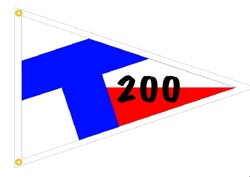
The Texas 200 is an endurance event, sailing the Texas Gulf coast for 200 miles
starting near the Texas-Mexico border and heading north.
Below is my account of the 2013 Texas 200 aboard Cupholder with crewman Beavis. Cupholder is a 17' gaff-rigged keel catboat with 30" draft.
Click the small photos to view a larger version.
Friday 7 June 2013
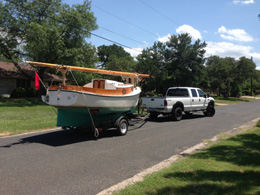 Beavis and I towed the catboat to White Sands Motel and Marina in
Port Isabel. From Austin it took all day, about 375 miles, using Beavis's
diesel Ford F250 four-wheel-drive pickup truck.
Beavis and I towed the catboat to White Sands Motel and Marina in
Port Isabel. From Austin it took all day, about 375 miles, using Beavis's
diesel Ford F250 four-wheel-drive pickup truck.
The Texas 200 starts Monday. Beavis and I will sail the catboat north from Port Isabel near the Texas-Mexico border to Magnolia Beach, TX. It is 200 miles, and we expect to arrive on Friday June 14.
The prevailing wind is from the south, so if the winds prevail it will be a good
point of sailing for any sailboat and especially a catboat.
Saturday 8 June
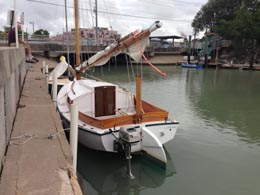 Launched in the morning, no problems, first time the catboat has been in salt
water. To step the mast, we used a bridge just 50 yards from the marina.
I spotted this bridge on Google Street
View weeks ago and knew it would work.
A local fellow, Walter, and Beavis carried the mast onto the bridge, and Kevin Green
and I motored the catboat up. Although the bridge was low, it provided enough
height to lower the mast into the step.
Launched in the morning, no problems, first time the catboat has been in salt
water. To step the mast, we used a bridge just 50 yards from the marina.
I spotted this bridge on Google Street
View weeks ago and knew it would work.
A local fellow, Walter, and Beavis carried the mast onto the bridge, and Kevin Green
and I motored the catboat up. Although the bridge was low, it provided enough
height to lower the mast into the step.
At this point, I have no idea how or where to get it out. I got the boom and gaff spars rigged by 1:30 and took a break. Came back and laced on the sail and was done rigging by 5:00 pm.
No surprises so far.
Sunday 9 June
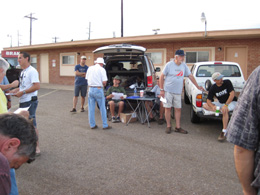 Thirty to 40 captains and crew met at 7:00 am to sign their waivers. This piece
of paper informs the participant that the Texas 200 is an endurance event, that
there are natural dangers, and that you can be injured or killed. The phrase
"you can die" appears three times. It is the truth, and the waiver is
required to make sure participants know it.
Thirty to 40 captains and crew met at 7:00 am to sign their waivers. This piece
of paper informs the participant that the Texas 200 is an endurance event, that
there are natural dangers, and that you can be injured or killed. The phrase
"you can die" appears three times. It is the truth, and the waiver is
required to make sure participants know it.
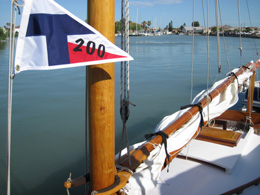 I bought a Texas 200 burgee, which is a very nice graphic design and nicely
made. I will fly it from the flag halyard on the catboat.
I bought a Texas 200 burgee, which is a very nice graphic design and nicely
made. I will fly it from the flag halyard on the catboat.
Beavis left at 8:30 am to take the truck and trailer north to Magnolia Beach. He caught the Texas 200 shuttle bus back. It was a long day for Beavis: four hours drive north, and 5 hours on the bus coming back. The bus ticket was $75.00, and it made the most sense logistically.
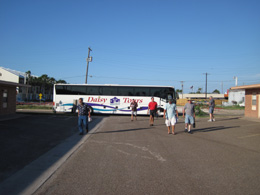 Beavis got back at 7 pm. Northbound, he hit rain and was checked by Border Patrol.
The coach was Greyhound-bus sized. Twenty-five sailors rode the bus. Most
were captains, so the docks in Port Isabel were pretty vacant all day.
Beavis got back at 7 pm. Northbound, he hit rain and was checked by Border Patrol.
The coach was Greyhound-bus sized. Twenty-five sailors rode the bus. Most
were captains, so the docks in Port Isabel were pretty vacant all day.
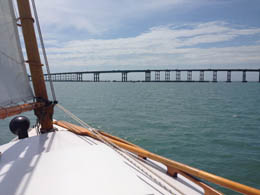 Walter, who helped step the mast on Saturday, came with me for a trial sail on
Sunday. He has lived in Port Isabel most of his life. We headed straight under
the Queen Isabella causeway and then through the jetty. Sailed into the
Gulf of Mexico on 4 foot swells then headed back, about 10 miles round trip.
Running home I saw 6-7 mph of boat speed. Walter plans to sail the Texas 200 in
2014. We talked about boats, and he had some good stories about his life in
Port Isabel.
Walter, who helped step the mast on Saturday, came with me for a trial sail on
Sunday. He has lived in Port Isabel most of his life. We headed straight under
the Queen Isabella causeway and then through the jetty. Sailed into the
Gulf of Mexico on 4 foot swells then headed back, about 10 miles round trip.
Running home I saw 6-7 mph of boat speed. Walter plans to sail the Texas 200 in
2014. We talked about boats, and he had some good stories about his life in
Port Isabel.
Monday 10 June
We spent a couple hours loading the boat with our stuff. We have 14 gallons of water in two water jugs. We have a cooler of ice, some cans of beer, a half gallon of milk, and another two gallons of water to boot. We have two plastic storage bins full of food, a kitchen kit, and a white-gas Coleman stove I bought in 1984 and has worked flawlessly for nearly 30 years with no maintenance that I can recall.
We left Port Isabel after 9:00 am, about the last boat to leave, although the catamaran was still tied up. We will sail the route inshore on bay waters. We raised sail at 9:30 and sailed one 40+ mile starboard tack to Port Mansfield. Initially winds were light and (surprisingly) northeast. We got 3.5 knots until 11 am when the wind picked up and we increased speed to 4.5 knots then 5.5 knots.
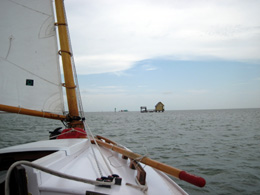 During the day's sail, we passed 25+ fishing shacks on stilts or pilings on the
east side of the Intracoastal Waterway over a stretch of 5 miles. Some were
near ruins, but some were very nice sporting rainwater catchment tanks and solar
panels.
During the day's sail, we passed 25+ fishing shacks on stilts or pilings on the
east side of the Intracoastal Waterway over a stretch of 5 miles. Some were
near ruins, but some were very nice sporting rainwater catchment tanks and solar
panels.
We eventually caught up to the group and saw Marty Houston, the one-masted Laguna, Puffin, Terio, Shalom, etc. At Port Mansfield, we entered the harbor with Sweet Pea and Stan Roberts.
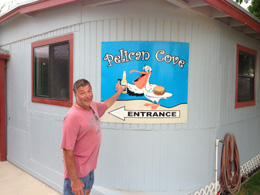 It was 4:00 pm when we arrived in Port Mansfield. We docked at the Pelican Cove pub
to eat since we only had a yogurt and watermelon all day.
It was 4:00 pm when we arrived in Port Mansfield. We docked at the Pelican Cove pub
to eat since we only had a yogurt and watermelon all day.
The group at large
was tied to Port Mansfield Chamber of Commerce docks.
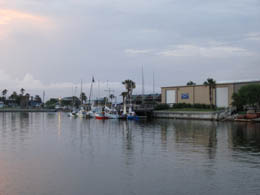 The Chamber opened the doors
of their pavillion for the club, a really friendly act. Everyone we met in Port
Mansfield was friendly. Nice town.
The Chamber opened the doors
of their pavillion for the club, a really friendly act. Everyone we met in Port
Mansfield was friendly. Nice town.
A few guys from the Texas 200 showed up at the Pelican around 6:30 since it is a short walk from the Chamber's pavillion.
Although we paid for dockage at the pub the cabin was too hot, even at midnight.
The pub itself blocked all the breeze. I prepared the anchor, and we moved into
open air and dropped hook in the middle of Port Mansfield harbor. Much much
better.
Tuesday 11 June
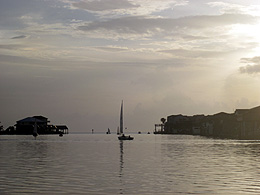 Arose at dawn, made coffee on the Coleman stove, and motored over to the Chamber
pavillion to use the facilities and to top up a water jug. We were next-to-last
out of Port Mansfield harbor and had our sail up at 8:00 am.
Arose at dawn, made coffee on the Coleman stove, and motored over to the Chamber
pavillion to use the facilities and to top up a water jug. We were next-to-last
out of Port Mansfield harbor and had our sail up at 8:00 am.
This is the "day of the ditch," the day we sail the entire length of the Land Cut, a portion of the Intracoastal Waterway some 25 miles long through a portion of the Laguna Madre where there is not much water at all.
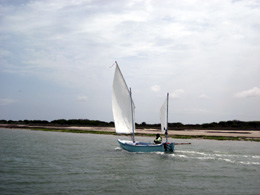 Winds were south and thus dead astern in the morning. They picked up and
soon we were doing 5.5 knots. By 1:30 pm, they shifted a little more eastward,
almost abeam, and I could sail a little more relaxed. Six knots speed was
common for us, sometimes seeing 6.5 knots. I have no anemometer, but weather
radio says 15 knots of SE wind.
Winds were south and thus dead astern in the morning. They picked up and
soon we were doing 5.5 knots. By 1:30 pm, they shifted a little more eastward,
almost abeam, and I could sail a little more relaxed. Six knots speed was
common for us, sometimes seeing 6.5 knots. I have no anemometer, but weather
radio says 15 knots of SE wind.
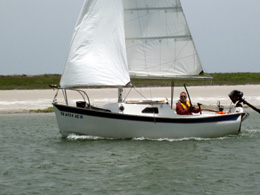 We caught up to some boats in the group. Every boat with two sails was
wing-on-wing: the sloops for sure and also the ketches and yawls. Jack LaBarge
on Shalom showed pirate style by waving a sword and growling "Arrrr!"
We caught up to some boats in the group. Every boat with two sails was
wing-on-wing: the sloops for sure and also the ketches and yawls. Jack LaBarge
on Shalom showed pirate style by waving a sword and growling "Arrrr!"
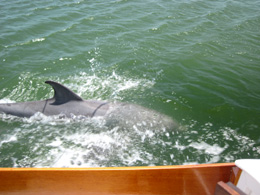 The dolphins made frequent appearances, usually in pairs or more. In the Land
Cut, we counted a dozen at once. Several times, a pair would swim alongside
just inches from the boat. At one point, there were a pair on both sides of the
catboat as if they were escorts. We imagined the dolphins appreciated a boat
without a rotating prop, and also one with no depth sounder making clicking
noises that might offend a porpoise. Who knows?
The dolphins made frequent appearances, usually in pairs or more. In the Land
Cut, we counted a dozen at once. Several times, a pair would swim alongside
just inches from the boat. At one point, there were a pair on both sides of the
catboat as if they were escorts. We imagined the dolphins appreciated a boat
without a rotating prop, and also one with no depth sounder making clicking
noises that might offend a porpoise. Who knows?
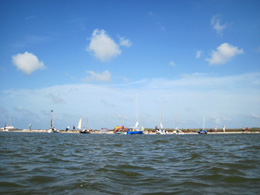 We emerged from the Land Cut and sailed 10 more miles to Camp 2 near the mouth
of Baffin Bay. We were boat 7 or 8. Dropped sail and anchored in 4' of water
off a spoils island at 27.285947,-97.405858, a sail of over 50 miles, all on one
starboard tack.
We emerged from the Land Cut and sailed 10 more miles to Camp 2 near the mouth
of Baffin Bay. We were boat 7 or 8. Dropped sail and anchored in 4' of water
off a spoils island at 27.285947,-97.405858, a sail of over 50 miles, all on one
starboard tack.
Beavis and I took a wade to shore. The bottom was sandy, and I only sunk a couple inches, yet I found some ankle deep mud in places getting to shore. Boats either anchor or beach. When all the boats finally showed up (the catamaran came in after dark) there were 10 anchored and 11 on shore.
While on shore, we heard rumors that some boats had dropped out, but since we are anchored off the beach, we were not hearing the latest talk. Cell phone service was non-existent throughout the day, but here I occasionally see one bar. To get a text to Sheila, I put my phone in a bag and ran it up the mast. I received texts more easily than I could send them. Sending was sure dodgey.
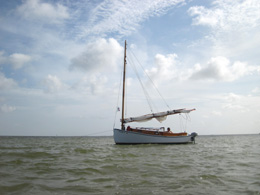 I made rice with canned black beans with pieces of beef jerky mixed in. We
have finished the smaller bottles of water and have now dipped into the large
water jugs on board. Beer consumption is less than I expected. Alcohol in
general can lead to dehydration, and dehydration might be the number one cause
for sailors to drop out of the Texas 200.
I made rice with canned black beans with pieces of beef jerky mixed in. We
have finished the smaller bottles of water and have now dipped into the large
water jugs on board. Beer consumption is less than I expected. Alcohol in
general can lead to dehydration, and dehydration might be the number one cause
for sailors to drop out of the Texas 200.
Wednesday 12 June
Awoke, made coffee, lifted anchor, then ran aground. My mistake, an awful mistake. I planned the Tuesday-night approach to Camp 2 so carefully, and it was fine: leave the Intracoastal Waterway channel and head to Camp 2 when it bears 45 degrees.
I should have headed out the the way I came in, an opposite heading of 225 degrees. But this morning, I blindly followed other boats across a shoal.
We got the sail up, then ran aground. Dropped sail. I jumped into the bay and pushed her off then hit ground again as soon as I got back on board. Freed her again and grounded a third time. Beavis and I both got out of the boat and pushed, and nearly exhausted ourselves. Beavis lost his shoes and my Teva sandals rubbed my feet raw. After an hour of this fight, we men of advanced age simply had to stop and rest. We sat in the boat and drank a quart of water each. We were both stunned. As we sat, the waves would lift the boat and drop her, making the matter worse as she dug herself deeper into the sand.
I was wishing for a come-a-long or a block and tackle. That's what the crew used in the book "Me, the Boy, and the Cat." They had to kedge off shoals almost every day on their journey from Rhode Island to Miami in 1912.
Well, the throat halyard on the catboat is a block and tackle with one end secured high on the mast. I disconnected the lower end from the gaff and strung it to the anchor which I hand carried and set 100' off the side of the boat. Beavis hauled on it, and she came loose when her gunnel went under water, a heel of 30+ degrees. Right then, a fishing boat showed up and three men were in the water helping us push, collecting and stowing the anchor, and telling me to get in the boat. Yes sir. We motored toward the channel, and fetched up one more time. I was immediately in the water pushing. Over the shoal we went, and we were deep water at last. It was noon time; it took four hours to get free.
We motored for a few miles to settle down and catch our breath. I had swallowed enough seawater to leave a lousy taste in my mouth, so I drank a beer to clear it, which worked.
Beavis stowed the anchor and I re-rigged the throat halyard. We were sailing again by 1:00 pm with 50 miles before us. We were setting off 5 or 6 hours behind the group.
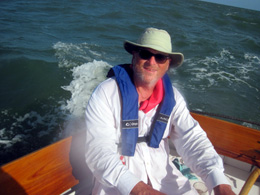 We stopped once near the JFK Causeway for 40 pounds of ice and Cokes and
sandwiches to go. We entered the Corpus Christi Bay at 4:30 pm and crossed it
by 6:15 pm. That was a fun romp, riding over swells of 2' with all sail up in 16
knots of wind. On reaching the Corpus Christi ship channel, we turned east into
an east wind. We dropped sail and motored to Port Aransas, about 9
miles, at 5+ knots.
We stopped once near the JFK Causeway for 40 pounds of ice and Cokes and
sandwiches to go. We entered the Corpus Christi Bay at 4:30 pm and crossed it
by 6:15 pm. That was a fun romp, riding over swells of 2' with all sail up in 16
knots of wind. On reaching the Corpus Christi ship channel, we turned east into
an east wind. We dropped sail and motored to Port Aransas, about 9
miles, at 5+ knots.
We got near Quarantine Shore (Camp 3) as dusk was just about gone. I could
barely see the masts of the group with binoculars. We headed for them and hit
ground again. Having been to school for this, I dropped sail and jumped in the
bay to push off as Beavis started the motor and threw her into reverse. We were
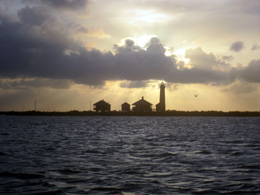 off the shoal and into 4' water in seconds. Daylight was gone. Nothing else to
do but drop anchor in the open waters of Aransas Bay in 18 knots of wind and
1-2' feet of bay chop.
off the shoal and into 4' water in seconds. Daylight was gone. Nothing else to
do but drop anchor in the open waters of Aransas Bay in 18 knots of wind and
1-2' feet of bay chop.
It was the roughest anchorage ever. The least motion was below in the berth. The catboat would swing on her anchor until she was very near abeam of the chop and just rock wildly. She would swing back and settle briefly and then catch the chop on her other beam. Too rough to try cooking, also too tired. Beavis decided to sleep in the cockpit. About when he fell asleep, the rocking rolled him off the cockpit seat and there was a mighty thud as he hit the cockpit sole. He was OK, then proceeded to move below.
Amid the mess, there were good signs: It was the first time I have seen Venus
since she returned as the evening star in late May. Also there are
phosphorescent creatures in the water. I never knew this about Texas bay
waters, although I have seen them in the British Virgin Islands. Just take up a
bucket of seawater and dump it back and you see hundreds of pinpoints of green
light.
Thursday 13 June
The wind laid down overnight, and the rolling boat settled down. Certainly no mosquitoes. Mosquitoes were supposed to be really bad down here, and I made screens especially for the boat, but we've been far enough from shore that they are not a problem. I could have skipped making screens.
Got up, made coffee. Kevin Green motored our way and said he heard we had dropped out. "Rumors of our demise are greatly exaggerated," we told him. Later, the spirit of the stairs told me, "Unlike us, rumors of our demise were ungrounded."
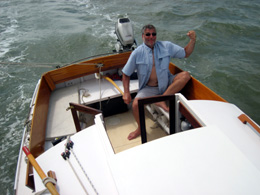 We were number 7 or 8 heading out. Sailed across Aransas Bay, which is about
10' deep for 10 miles then rejoined the channel and sailed past Rockport and
Fulton. I spotted the large Copano Bay bridge and Goose Island State Park.
We were number 7 or 8 heading out. Sailed across Aransas Bay, which is about
10' deep for 10 miles then rejoined the channel and sailed past Rockport and
Fulton. I spotted the large Copano Bay bridge and Goose Island State Park.
At 1:00 pm, we hit the mark where I expected to leave the channel and enter San
Antonio Bay. We would cross it and Espiritu Santo Bay to Army Hole (Camp 4) on
Matagorda Island. My planned route took us through Panther Reef cut and South
Pass.
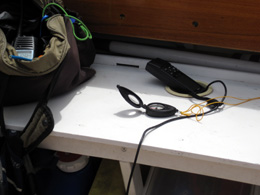 But the boats around us just stayed in the channel, and I lost my nerve.
We stayed in the channel, too. The charts show these cuts and passes are 4'
deep, and the sands do shift. I will not know if we could have made it across
the bays. We will take the channel route instead.
But the boats around us just stayed in the channel, and I lost my nerve.
We stayed in the channel, too. The charts show these cuts and passes are 4'
deep, and the sands do shift. I will not know if we could have made it across
the bays. We will take the channel route instead.
The Intracoastal Waterway ship channel turned eastward, and so did the wind. It was nearly on our nose. I started the motor but left the sail up because we had to move, move, move to cover the additional miles to Army Hole imposed by sailing the channels.
At 3:00 pm, Beavis and I both sensed a drop in motor RPMs, which was alarming, and the motor died. I squeezed the bulb on the fuel supply line, and the motor restarted on one pull. But in 5 minutes, her RPMs sagged again. I squeezed the bulb and she perked up. So, the motor has some kind of fuel starvation problem. Not fatal, but it is disconcerting. We kept up her RPMs by squeezing the bulb every 5 or 6 minutes.
We reached Blackberry Island at 6:00 pm and motor sailed into Espiritu Santo Bay in the channel to Army Hole. Having been traveling all day eastward into a easterly headwind, we were now headed south. As soon as we entered the bay, we found the wind on our nose again! Incredible. With just a few hours of daylight remaining, I could not justify motoring the 5 miles to windward to Army Hole with a half-sick motor, let alone hope to sail a windward beat in 2 hours. In my opinion, it was a journey to start at 6 am, not 6 pm.
We went about and resumed our previous easterly heading in the Intracoastal Waterway for a 5-mile sail to Port O'Connor. No motor needed now; the wind was more southerly than it had been most of the afternoon.
We sailed close to the vacation homes along the waterway. Most were vacated on this Thursday. One was occupied, and there were folks standing outdoors on the upper deck. They shouted, "Pretty boat," and I shouted, "Thank you! Can we come back Saturday and use your deck to lift out this mast?" They said yes, and I promised them a bottle of Beavis's tequila.
Clarks Inn in Port O'Connor is on the water, a hotel with a marina. We checked in, and Beavis said the shower felt so good, he was tempted to take another one. He was right. After cleaning up, we looked out the window and saw another sailboat tied in the marina, so we were not alone in the decision to skip Army Hole.
At 9:00 pm, we walked 2 miles to a surprisingly busy Mexican joint, and that's when we ran into the worst mosquitoes of the whole trip, buzzing my ears and flying up my nose.
I have bruises on my arms, and I don't bruise easily. The worst is from the grounding Wednesday evening, trying to find the group in the dark. There is a swollen spot on my forearm from hanging onto the boat as Beavis powered off the shoal in reverse. Otherwise my arms and legs ache, and I have a red back from Wednesday morning. I have cramps in both legs now as I write, and a place on my foot rubbed raw from wearing Teva sandals.
I am disappointed that we did not make Army Hole. I have camped there a half dozen times over the years, going by motor boat, and always dreamed of reaching it by sail. They call it Army Hole because there was an Army air force base there in WWII. The old runways are easily seen in Google Maps satellite view.
On the other hand, this hotel room feels pretty nice after 4 days on Texas bay waters. Beavis feels that way too, and he deserves it. He has been a great crewman, and took the Wednesday morning grounding in stride and in good spirit. As Beavis said of the trip, "It will be an adventure." As I said, "What can possibly go wrong?"
The Texas 200 started as an event for builders of a class of watercraft designed for the Texas bays. Bay sailing calls for a boat that can get out of the channel and sail across the bay shoals. The successful designs that have emerged these 7 years are center boarders or lee boarders with kick-up rudders, unballasted skiffs or peapods with a main and a mizzen. These boats will draw 8" loaded. The Laguna design is the most popular this trip; three of them started this year. Jim Myers' boat Terio looked very able; she's a double-ended canoe yawl. Everybody took interest in Sweet Pea, a sloop rigged Mirror sailing dinghy. Sweet Pea is having a great trip. Stan Roberts has sailed his Family Skiff in the Texas 200 for several years. Gamaray, a 14' Mayfly, and her owner Chuck Pierce have sailed the Texas 200 many times. These craft land on shore, and the owners sleep in tents. Longer designs might afford a place to sleep aboard on a bench seat or on the cockpit sole, like the folding schooner of Christopher Breaux. The builder who sails the Texas 200 in one of these designs is the epitome of the event.
The Texas 200 is a great event, so naturally other sailors with production craft have entered. Fixed keels and deeper drafts might keep them in the channel, but like everybody else, they still go home with a great story.
Participants today can be divided into two kinds, the on-shore campers and the
anchor-out campers. The Texas 200 social scene tends to be on
shore. Being a builder myself, I would have loved the on-shore talk and philosophizing,
but we were anchored out and plain dog tired every night anyway. Tomorrow at
Magnolia Beach, there will be an on-shore party and another chance to see all
the craft up close and talk some boat talk. I intend to beach the catboat for
sure.
Friday 14 June
Woke up to much different surrounds on Friday -- air conditioning and continental breakfast. We decided to skip Army Hole and stay at Clark's Inn in Port O'Connor. Good call for us. We later heard stories about difficulties crossing the bay, and hulls cracked on the Army Hole pilings, and people arriving as late as 1:00 am. The winds were not favorable for many, us included.
We were underway at 10 am heading for Magnolia Beach. From Port O'Connor, it was just 12 miles. We arrived quite early in the noon hour. The Army Holers had to go 22 miles. Still, 22 miles is a light day compared to the others.
The beach was nice. There was 3-4' of water right up next to shore, so we
sailed right up to the beach and dropped anchor on land.
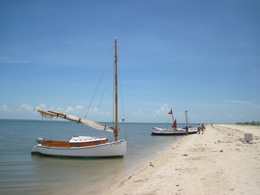 We were greeted by Chuck Leinweber, the fellow who had the idea for the Texas
200 back in 2006. Chuck is a boat builder and designer of craft well suited to
the Texas 200. Chuck gave Beavis a lift to the truck and soon Beavis returned and
parked the truck and trailer right in front of the boat. Driving and parking on
the sand at the beach is a Texas thing. You see it all along Mustang Island on
the Gulf side, Padre Island, too.
We were greeted by Chuck Leinweber, the fellow who had the idea for the Texas
200 back in 2006. Chuck is a boat builder and designer of craft well suited to
the Texas 200. Chuck gave Beavis a lift to the truck and soon Beavis returned and
parked the truck and trailer right in front of the boat. Driving and parking on
the sand at the beach is a Texas thing. You see it all along Mustang Island on
the Gulf side, Padre Island, too.
Shiner Beer is a sponsor of the Texas 200, so on arrival I was offered one. Shiner Bock is hugely popular in Texas, but they make other styles, and we had our pick of 6 or 7 different kinds you never see at the grocery store.
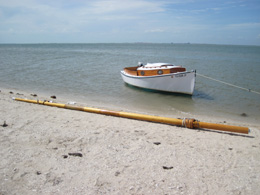 I took down the sailing rig, the gaff and boom and sail. As for the mast, Beavis
and I just lifted it up and let it fall into the bay. Beavis lost his balance, and
fell into the bay too, adding one more bruise. Unmasting by splashing is not
pretty. There was no convenient bridge as in Port Isabel.
I took down the sailing rig, the gaff and boom and sail. As for the mast, Beavis
and I just lifted it up and let it fall into the bay. Beavis lost his balance, and
fell into the bay too, adding one more bruise. Unmasting by splashing is not
pretty. There was no convenient bridge as in Port Isabel.
Trailering the boat went well. We did not use the boat ramp, nor did we have to disconnect the trailer. We just backed the trailer into the the sea right on the beach. The boat went on without a problem, and Beavis's four-wheel-drive truck pulled the boat and trailer right up and out.
There was a shrimp dinner catered by Bubba's of Seadrift. Bubba has a secret recipe for his boiled shrimp, and it was the best I ever had. I wondered aloud about the spices, but Bubba put on his poker face and went silent.
It was nearly 6 hours of work unrigging, but we finally wheeled out before dark
and headed for a motel in Port O'Connor. I had planned to unrig in Port
O'Connor on Saturday, but could find no place to tie up Friday night. Glad it's
done, and glad no one got hurt lifting out the mast.
Saturday 15 June
Time to head home. Had plenty of food and water left over, so made breakfast in the motel room. I got out the Coleman stove and heated water for coffee.
Two hundred miles to Austin, and the catboat is in the back yard.